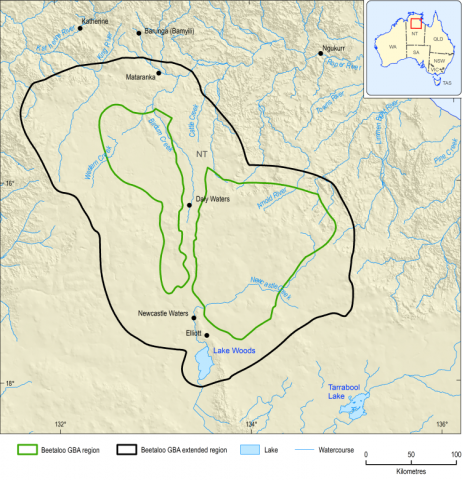- Home
- Impact assessment for the Beetaloo GBA region (stage 3)
- Explore this assessment
- Supporting information
User panels: The GBA Program is informed by user panels that provide a forum for the discussion and inclusion of user needs and concerns. User panels help guide the assessment process, provide a forum to communicate findings and enable the sharing of information for the regions. The user panel in the Beetaloo GBA region consists of representatives from relevant local governments, natural resource management bodies, Northern Territory Government, Traditional Owner groups, industry and other land user groups. The GBA Program team is grateful for the contributions of the user panel members over the course of this project.
Causal networks: Causal networks are used to assess potential impacts on water and the environment (Peeters et al., 2021b). They are graphical models that describe the cause-and-effect relationships between development activities and endpoints, the values to be protected, for example, the nationally important Mataranka Thermal Pools. Information can be accessed online through GBA Explorer.
GBA Program outputs: This synthesis is supported by the Stage 1 rapid regional prioritisation report, a Stage 2 geological and environmental baseline assessment report, and Stage 2 technical appendices. The Introduction to causal networks (Peeters et al., 2021a), the online technical impact assessment summary for the Beetaloo GBA region and the synthesis of findings from the impact assessment for the Beetaloo GBA region all use outputs from the interactive causal network, GBA Explorer.
Journal papers: Journal papers and fact sheets that support the method, outputs and investigations for the GBA Program are listed at bioregionalassessments.gov.au/gba. Listings will be updated as journal papers are completed and published.
Datasets: The full suite of information, including instruction on how to access GBA datasets through data.gov.au is provided at bioregionalassessments.gov.au/gba. Underpinning datasets, including geographic data and modelling results, will assist decision makers at all levels to review the work undertaken to date; explore the results using different thresholds; or using their own spatial analysis tools (e.g. ArcGIS, MapInfo or QGIS) to extend or update the assessment as new models and data become available.
The Program’s rigorous commitment to data access is consistent with the Australian Government’s principles of providing publicly accessible, transparent and responsibly managed public sector information.

